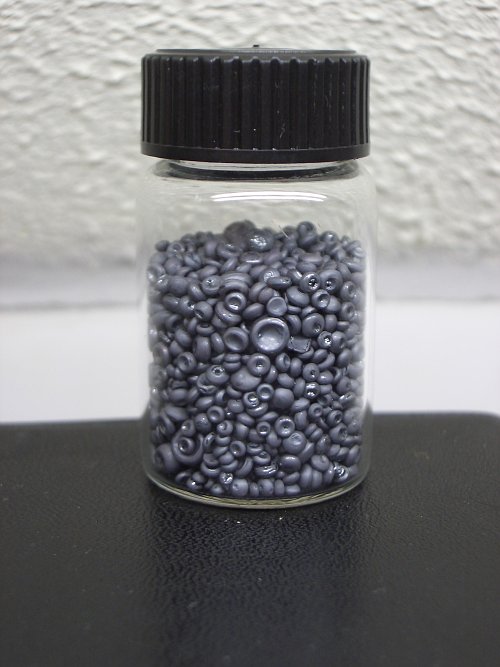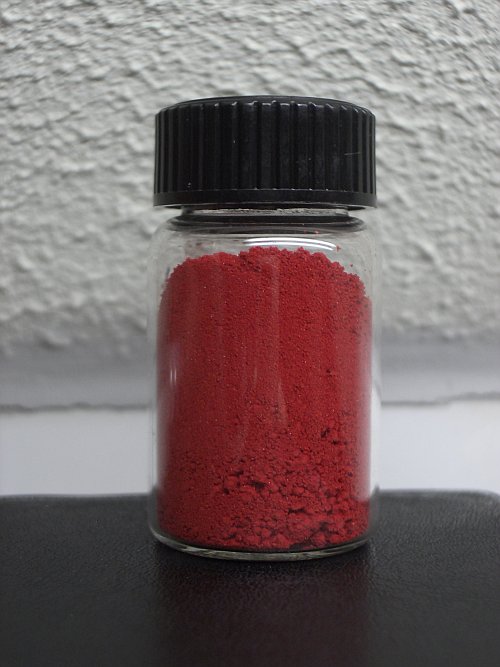


Selenium


Selenium, like sulphur, exists in different allotropic forms. At least 8 different allotropic forms of selenium are known, but these can be roughly divided in three groups. These groups are mentioned below the two pictures, which show the red and black allotropes.
The three main groups of allotropes are:
- Vitreous black form, consisting of a very complex mixture of large polymeric rings of selenium atoms, with up to ~1000 atoms per ring. This is the allotrope, which is available commercially and which is shown in the left picture. The red allotropes of selenium slowly are transformed to the vitreous black form.
- Red allotropic forms, consisting of Sen molecules. There are several Se8 forms, the main difference being the spatial distribution of the Se8 molecules. Recently, Se7 and Se6 allotropes have been synthesized as well. The right picture shows a red allotrope.
- 'Metallic' form, consisting of long polymeric chains of selenium atoms. The metallic form has a grey/black appearance with a metal-like lustre. There also is a form, close to the 'metallic' form, with deformed polymeric chains, which has a red appearance.
Selenium is a real-non-metallic element, with a chemistry, resembling that of sulphur in many respects. Selenium dissolves slowly in solutions of a soluble selenide or a soluble sulfide, forming polyselenides or polyselenosulfides. These solutions, containing polyselenides and polyselenosulfides are deep red.
Elementary selenium can be purchased sometimes on eBay in the form of fine shot at a reasonable price as shown in the left picture. Some photography raw chemical suppliers also sell elementary selenium as a very fine black powder. The fine powder, however, is quite expensive.
![]()
![]() Selenium, although
an essential trace element for humans, is quite toxic in larger quantities. Some
sources mention it as an accumulative poison. When working with selenium or its
compounds, be absolutely sure not to inhale any dust, fume or powder. For this
reason it is strongly advised to purchase the shot form of the element and not
the fine powder. Using the shot form is less convenient (it dissolves very
slowly, when used in aqueous chemistry experiments), but this shot form cannot
be inhaled and hence is less risky in its use.
Selenium, although
an essential trace element for humans, is quite toxic in larger quantities. Some
sources mention it as an accumulative poison. When working with selenium or its
compounds, be absolutely sure not to inhale any dust, fume or powder. For this
reason it is strongly advised to purchase the shot form of the element and not
the fine powder. Using the shot form is less convenient (it dissolves very
slowly, when used in aqueous chemistry experiments), but this shot form cannot
be inhaled and hence is less risky in its use.
Selenium waste definitely has to be processed by a proper chemical waste processing facility and shall not be flushed down the drain.
Selenium is not the first thing to be added to the home lab, but for the more advanced and careful home chemist, this may be a nice addition.
![]()
Selenium compounds can be purchased by the general public, but it is hard to find pure compounds besides the element.
The following compounds can be obtained.
- Cadmium red, which is a mixture of cadmium sulfide (CdS) and cadmium selenide (CdSe). The more of the selenide, the darker the color. Cadmium red can have colors, ranging from bright red to dark brown red. Cadmium red can be obtained at art and paint stores as a red pigment in many shades. If you really want to experiment with this, try to obtain the darkest possible cadmium red. It is a fairly cheap source of selenium.
- Kodak Rapid Selenium Toner (KRST). This is a concentrate of ammonium thiosulfate and sodium selenosulfite (Na2SeSO3). This toner liquid can be treated, such that the selenium precipitates as a red solid, which slowly turns black in the course of several days. KRST can be obtained at better equipped photography shops and at some photography chemical suppliers. KRST is quite expensive.
- Sodium selenite, Na2SeO3ĚH2O. This can be purchased at some chemical supply houses and might be available from photography raw chemical suppliers as a special order. This is a white crystalline solid.
Cadmium red, KRST and sodium selenite are very toxic compounds. It is suggested to use elementary selenium in shot form as a basis for experimenting with selenium, because isolating the selenium from the other compounds is quite dangerous.


![]() When cadmium red is
added to a non-oxidizing acid (e.g. hydrochloric acid or dilute sulphuric acid),
then the very poisonous hydrogen selenide gas is formed. This compound is much
more dangerous than a gas like chlorine or even hydrogen cyanide, due to its
long-term effects and the cumulative effect of selenium poisoning. Do not
perform experiments with hydrogen selenide at home!!! When you experiment
with gasses, then frequently you breathe a small amount of the gas, especially,
when no professional fume hood is available. For many gasses, even for gasses
like chlorine or hydrogen sulfide, this is not a real concern, when the
quantities are very small. For hydrogen selenide, however, this is a
concern. Hydrogen selenide is said to have a horrible smell, somewhat similar to
hydrogen sulfide, but the gas is much nastier than the already nasty hydrogen
sulfide.
When cadmium red is
added to a non-oxidizing acid (e.g. hydrochloric acid or dilute sulphuric acid),
then the very poisonous hydrogen selenide gas is formed. This compound is much
more dangerous than a gas like chlorine or even hydrogen cyanide, due to its
long-term effects and the cumulative effect of selenium poisoning. Do not
perform experiments with hydrogen selenide at home!!! When you experiment
with gasses, then frequently you breathe a small amount of the gas, especially,
when no professional fume hood is available. For many gasses, even for gasses
like chlorine or hydrogen sulfide, this is not a real concern, when the
quantities are very small. For hydrogen selenide, however, this is a
concern. Hydrogen selenide is said to have a horrible smell, somewhat similar to
hydrogen sulfide, but the gas is much nastier than the already nasty hydrogen
sulfide.